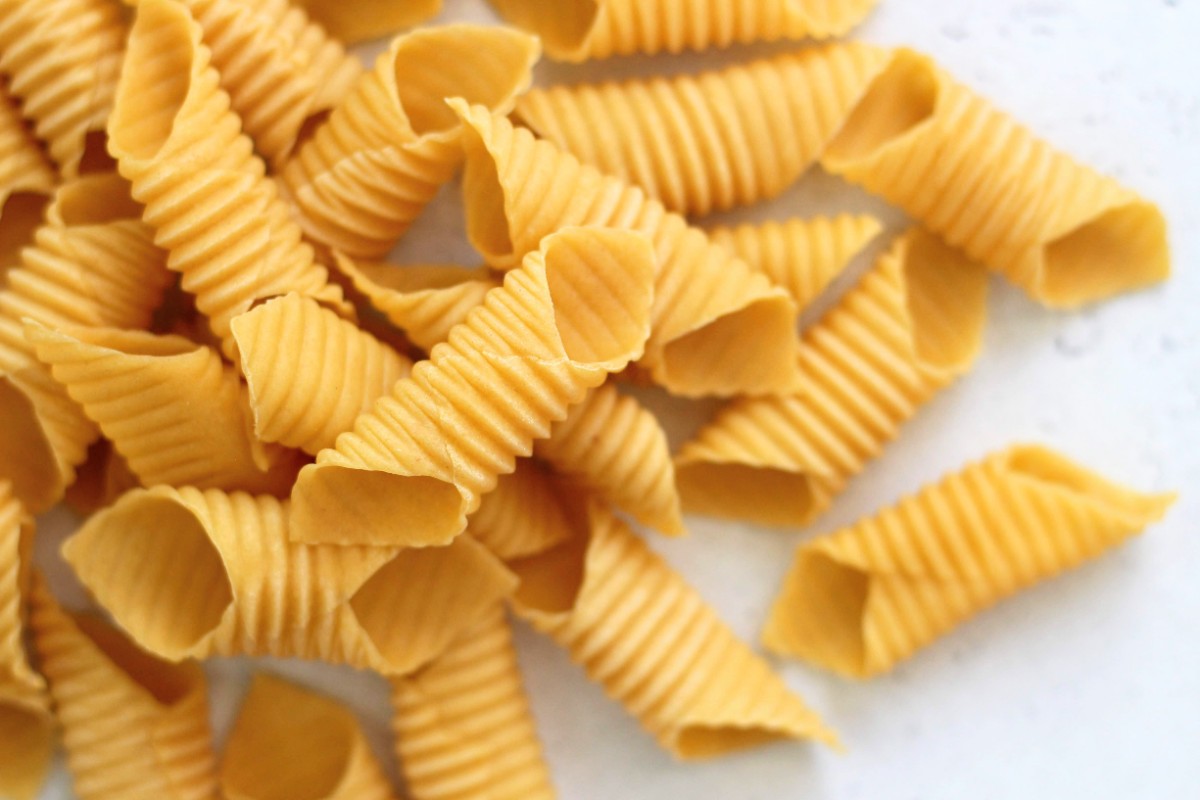
Homemade Garganelli Pasta
|
|
Time to read 3 min
|
|
Time to read 3 min
Garganelli are short, ridged tubes of fresh egg pasta. They’re traditionally made by hand by wrapping squares of fresh egg pasta dough diagonally around a wooden stick, then rolling each one across a ridged surface to form their characteristic grooves.
Garganelli are most prominently found in Emilia-Romagna, especially Lugo di Romagna. They get their name from the dialect word garganel meaning “chicken gullet,” thanks to their tubular shape and ridges which resemble an esophagus.
Although garganelli resemble penne rigate (lined penne), they’re slightly different. Penne pasta is most often extruded in a factory and sold as dry pasta. On the other hand, garganelli are typically prepared by hand using fresh egg pasta dough. And unlike penne, which are seamless tubes, garganelli tubes are formed by wrapping a square of dough diagonally around a rod, resulting in their signature flap at the seam.
You can also find dry garganelli pasta, a modern convenience made possible by large, industrial pasta companies. Garganelli are also sometimes colored green, thanks to the addition of spinach to the dough. In Italy, you can white and green dry garganelli packaged together and sold as paglia e fieno or “straw and hay.”
Legend has it that garganelli originated from a poor housewife’s last-minute resourcefulness. While she was preparing tortellini for her guests, she was disappointed to find that her cat ate the tortellini filling! So, in an effort to salvage her dinner party, she took the squares of pasta she had already cut for her tortellini then rolled them around a stick and over a loom comb.
There are a couple of tools you can use to make garganelli. The first is a ridged, wooden board . Made from a single piece of carved wood, this is considered the “modern” tool.
The second and most traditional garganelli tool is a pettine per la pasta , or pasta comb (Learn more about the pettine’s peculiar history here .). The antique treasure is traditionally made by hand, using more than 50 thin slats of wood secured by jute string, tightly wrapped around two wooden posts straddling each side of the board. The thin slats of wood are what give garganelli its tiny and numerous ridges, perfect for capturing sauce. Since the pettine is made by hand, the wood slats are not always perfectly aligned, which gives the garganelli a more rustic look.
Both tools work great for garganelli, as well as gnocchi and malloreddus.
According to Pasta Encyclopedia, garganelli used to be served in capon broth and the dough was scented with nutmeg and enriched with local cheese. However today, garganelli are principally served with the hearty ragù alla bolognese , or with a simple combination of butter, peas, and prosciutto.

25 minutes, plus 30 minutes resting
5 minutes
4
540 grams fresh pasta dough
Prepare the pasta dough ( see recipe here ).
Set aside two pasta trays or baking sheets lined with parchment or a tea towel.
After the pasta dough has rested for at least 30 minutes, unwrap and cut the dough into equal quarters. Take one piece of dough and wrap up the remaining dough to keep it from drying out.
Roll the ¼ piece of dough through the widest setting on your pasta machine . Roll it again through the second widest and the third. Next, take your sheet of dough and fold it over onto itself like a trifold brochure. Roll the “brochure” through the widest setting on your pasta machine again, then again through the second and third setting. Continue rolling the sheet through all the way to the second to last setting on your pasta machine.
Using a knife, pasta wheel (rotelle), or pasta cutter (tagliapasta), cut the sheet of dough into 1 ¼ inch squares. Cover half the dough with a damp tea towel or plastic wrap to keep it from drying out as you work.
Take a single square and wrap it diagonally around the wooden rod. Place the wooden rod on your board or pasta comb , making sure the pasta is centered, and roll across to form ridges crosswise.
Gently remove the now formed garganelli from the rod and place on a pasta rack or lined baking sheet.
To serve, cook in salted boiling water for a few minutes, until al dente. Serve with ragù alla bolognese and freshly grated Parmigiano Reggiano cheese.
Variations: You can also try making green garganelli by adding cooked spinach to your pasta dough.